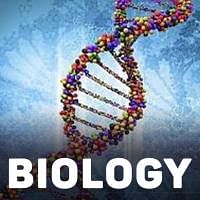NEET Exam > NEET Questions > Hardy-Weinberg operates in the absence of:a)M...
Start Learning for Free
Hardy-Weinberg operates in the absence of:
- a)Mutations
- b)Natural selection
- c)Recombination
- d)All of these
Correct answer is option 'D'. Can you explain this answer?
| FREE This question is part of | Download PDF Attempt this Test |
Most Upvoted Answer
Hardy-Weinberg operates in the absence of:a)Mutationsb)Natural selecti...
Hardy-Weinberg equilibrium is a mathematical model that describes the relationship between allele frequencies and genotype frequencies in a population. The equilibrium operates under certain assumptions, which include the absence of mutations, natural selection, migration, and genetic drift. However, the equilibrium can be disrupted by any of these factors, leading to changes in allele and genotype frequencies over time.
Explanation:
Assumptions of Hardy-Weinberg equilibrium:
The Hardy-Weinberg equilibrium assumes the following conditions:
1. Large population size: The population is large enough to prevent genetic drift, which is the random fluctuation of allele frequencies due to chance events.
2. Random mating: The individuals in the population mate randomly, without any preference for certain traits or genetic backgrounds.
3. No migration: There is no movement of individuals into or out of the population, which could introduce new alleles or remove existing ones.
4. No mutations: There are no new mutations arising in the population, which could alter the genetic code and create new alleles.
5. No natural selection: There is no differential survival or reproduction of individuals based on their genotype, which could favor certain alleles over others.
Consequences of violating the assumptions:
If any of these assumptions is violated, the equilibrium will be disrupted, and the allele and genotype frequencies will change over time. For instance:
1. Small population size: In a small population, genetic drift can have a significant effect on allele frequencies, leading to the loss or fixation of alleles.
2. Non-random mating: If individuals mate preferentially based on certain traits or genetic backgrounds, it can create non-random associations between alleles and increase the frequency of certain genotypes.
3. Migration: If individuals move into or out of the population, it can introduce new alleles or remove existing ones, altering the genetic makeup of the population.
4. Mutations: If new mutations arise, they can create new alleles or alter existing ones, leading to changes in allele frequencies.
5. Natural selection: If certain genotypes have a higher fitness than others, they will be more likely to survive and reproduce, leading to changes in allele frequencies.
Conclusion:
In summary, the Hardy-Weinberg equilibrium is a useful tool for understanding how allele and genotype frequencies are related in a population, but it operates under certain assumptions that may not always be true in real-world populations. By violating these assumptions, various factors can disrupt the equilibrium and cause changes in the genetic makeup of a population over time.
Explanation:
Assumptions of Hardy-Weinberg equilibrium:
The Hardy-Weinberg equilibrium assumes the following conditions:
1. Large population size: The population is large enough to prevent genetic drift, which is the random fluctuation of allele frequencies due to chance events.
2. Random mating: The individuals in the population mate randomly, without any preference for certain traits or genetic backgrounds.
3. No migration: There is no movement of individuals into or out of the population, which could introduce new alleles or remove existing ones.
4. No mutations: There are no new mutations arising in the population, which could alter the genetic code and create new alleles.
5. No natural selection: There is no differential survival or reproduction of individuals based on their genotype, which could favor certain alleles over others.
Consequences of violating the assumptions:
If any of these assumptions is violated, the equilibrium will be disrupted, and the allele and genotype frequencies will change over time. For instance:
1. Small population size: In a small population, genetic drift can have a significant effect on allele frequencies, leading to the loss or fixation of alleles.
2. Non-random mating: If individuals mate preferentially based on certain traits or genetic backgrounds, it can create non-random associations between alleles and increase the frequency of certain genotypes.
3. Migration: If individuals move into or out of the population, it can introduce new alleles or remove existing ones, altering the genetic makeup of the population.
4. Mutations: If new mutations arise, they can create new alleles or alter existing ones, leading to changes in allele frequencies.
5. Natural selection: If certain genotypes have a higher fitness than others, they will be more likely to survive and reproduce, leading to changes in allele frequencies.
Conclusion:
In summary, the Hardy-Weinberg equilibrium is a useful tool for understanding how allele and genotype frequencies are related in a population, but it operates under certain assumptions that may not always be true in real-world populations. By violating these assumptions, various factors can disrupt the equilibrium and cause changes in the genetic makeup of a population over time.
Free Test
FREE
| Start Free Test |
Community Answer
Hardy-Weinberg operates in the absence of:a)Mutationsb)Natural selecti...
Mutation. recombination and natural selection all are able to change gene or allele frequency in species
Attention NEET Students!
To make sure you are not studying endlessly, EduRev has designed NEET study material, with Structured Courses, Videos, & Test Series. Plus get personalized analysis, doubt solving and improvement plans to achieve a great score in NEET.

|
Explore Courses for NEET exam
|

|
Hardy-Weinberg operates in the absence of:a)Mutationsb)Natural selectionc)Recombinationd)All of theseCorrect answer is option 'D'. Can you explain this answer?
Question Description
Hardy-Weinberg operates in the absence of:a)Mutationsb)Natural selectionc)Recombinationd)All of theseCorrect answer is option 'D'. Can you explain this answer? for NEET 2024 is part of NEET preparation. The Question and answers have been prepared according to the NEET exam syllabus. Information about Hardy-Weinberg operates in the absence of:a)Mutationsb)Natural selectionc)Recombinationd)All of theseCorrect answer is option 'D'. Can you explain this answer? covers all topics & solutions for NEET 2024 Exam. Find important definitions, questions, meanings, examples, exercises and tests below for Hardy-Weinberg operates in the absence of:a)Mutationsb)Natural selectionc)Recombinationd)All of theseCorrect answer is option 'D'. Can you explain this answer?.
Hardy-Weinberg operates in the absence of:a)Mutationsb)Natural selectionc)Recombinationd)All of theseCorrect answer is option 'D'. Can you explain this answer? for NEET 2024 is part of NEET preparation. The Question and answers have been prepared according to the NEET exam syllabus. Information about Hardy-Weinberg operates in the absence of:a)Mutationsb)Natural selectionc)Recombinationd)All of theseCorrect answer is option 'D'. Can you explain this answer? covers all topics & solutions for NEET 2024 Exam. Find important definitions, questions, meanings, examples, exercises and tests below for Hardy-Weinberg operates in the absence of:a)Mutationsb)Natural selectionc)Recombinationd)All of theseCorrect answer is option 'D'. Can you explain this answer?.
Solutions for Hardy-Weinberg operates in the absence of:a)Mutationsb)Natural selectionc)Recombinationd)All of theseCorrect answer is option 'D'. Can you explain this answer? in English & in Hindi are available as part of our courses for NEET.
Download more important topics, notes, lectures and mock test series for NEET Exam by signing up for free.
Here you can find the meaning of Hardy-Weinberg operates in the absence of:a)Mutationsb)Natural selectionc)Recombinationd)All of theseCorrect answer is option 'D'. Can you explain this answer? defined & explained in the simplest way possible. Besides giving the explanation of
Hardy-Weinberg operates in the absence of:a)Mutationsb)Natural selectionc)Recombinationd)All of theseCorrect answer is option 'D'. Can you explain this answer?, a detailed solution for Hardy-Weinberg operates in the absence of:a)Mutationsb)Natural selectionc)Recombinationd)All of theseCorrect answer is option 'D'. Can you explain this answer? has been provided alongside types of Hardy-Weinberg operates in the absence of:a)Mutationsb)Natural selectionc)Recombinationd)All of theseCorrect answer is option 'D'. Can you explain this answer? theory, EduRev gives you an
ample number of questions to practice Hardy-Weinberg operates in the absence of:a)Mutationsb)Natural selectionc)Recombinationd)All of theseCorrect answer is option 'D'. Can you explain this answer? tests, examples and also practice NEET tests.

|
Explore Courses for NEET exam
|

|
Suggested Free Tests
Signup for Free!
Signup to see your scores go up within 7 days! Learn & Practice with 1000+ FREE Notes, Videos & Tests.

















